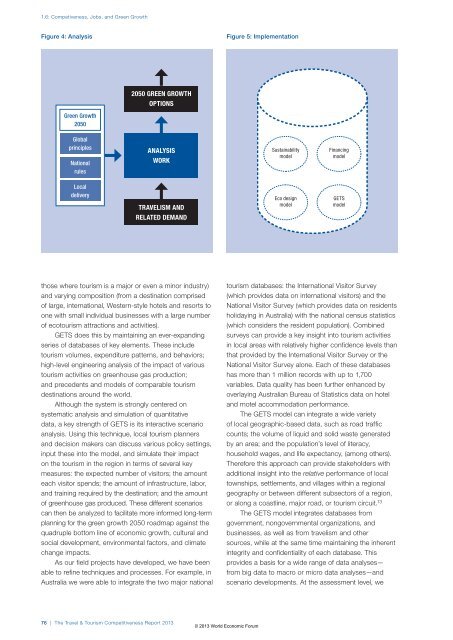The Travel & Tourism Competitiveness Report 2013
The Travel & Tourism Competitiveness Report 2013
The Travel & Tourism Competitiveness Report 2013
You also want an ePaper? Increase the reach of your titles
YUMPU automatically turns print PDFs into web optimized ePapers that Google loves.
1.6: Competiveness, Jobs, and Green Growth<br />
Figure 4: Analysis Figure 5: Implementation<br />
Green Growth<br />
2050<br />
Global<br />
principles<br />
National<br />
rules<br />
Local<br />
delivery<br />
2050 GREEN GROWTH<br />
OPTIONS<br />
ANALYSIS<br />
WORK<br />
TRAVELISM AND<br />
RELATED DEMAND<br />
those where tourism is a major or even a minor industry)<br />
and varying composition (from a destination comprised<br />
of large, international, Western-style hotels and resorts to<br />
one with small individual businesses with a large number<br />
of ecotourism attractions and activities).<br />
GETS does this by maintaining an ever-expanding<br />
series of databases of key elements. <strong>The</strong>se include<br />
tourism volumes, expenditure patterns, and behaviors;<br />
high-level engineering analysis of the impact of various<br />
tourism activities on greenhouse gas production;<br />
and precedents and models of comparable tourism<br />
destinations around the world.<br />
Although the system is strongly centered on<br />
systematic analysis and simulation of quantitative<br />
data, a key strength of GETS is its interactive scenario<br />
analysis. Using this technique, local tourism planners<br />
and decision makers can discuss various policy settings,<br />
input these into the model, and simulate their impact<br />
on the tourism in the region in terms of several key<br />
measures: the expected number of visitors; the amount<br />
each visitor spends; the amount of infrastructure, labor,<br />
and training required by the destination; and the amount<br />
of greenhouse gas produced. <strong>The</strong>se different scenarios<br />
can then be analyzed to facilitate more informed long-term<br />
planning for the green growth 2050 roadmap against the<br />
quadruple bottom line of economic growth, cultural and<br />
social development, environmental factors, and climate<br />
change impacts.<br />
As our field projects have developed, we have been<br />
able to refine techniques and processes. For example, in<br />
Australia we were able to integrate the two major national<br />
76 | <strong>The</strong> <strong>Travel</strong> & <strong>Tourism</strong> <strong>Competitiveness</strong> <strong>Report</strong> <strong>2013</strong><br />
Sustainability<br />
model<br />
Eco design<br />
model<br />
Financing<br />
model<br />
GETS<br />
model<br />
tourism databases: the International Visitor Survey<br />
(which provides data on international visitors) and the<br />
National Visitor Survey (which provides data on residents<br />
holidaying in Australia) with the national census statistics<br />
(which considers the resident population). Combined<br />
surveys can provide a key insight into tourism activities<br />
in local areas with relatively higher confidence levels than<br />
that provided by the International Visitor Survey or the<br />
National Visitor Survey alone. Each of these databases<br />
has more than 1 million records with up to 1,700<br />
variables. Data quality has been further enhanced by<br />
overlaying Australian Bureau of Statistics data on hotel<br />
and motel accommodation performance.<br />
<strong>The</strong> GETS model can integrate a wide variety<br />
of local geographic-based data, such as road traffic<br />
counts; the volume of liquid and solid waste generated<br />
by an area; and the population’s level of literacy,<br />
household wages, and life expectancy, (among others).<br />
<strong>The</strong>refore this approach can provide stakeholders with<br />
additional insight into the relative performance of local<br />
townships, settlements, and villages within a regional<br />
geography or between different subsectors of a region,<br />
or along a coastline, major road, or tourism circuit. 13<br />
<strong>The</strong> GETS model integrates databases from<br />
government, nongovernmental organizations, and<br />
businesses, as well as from travelism and other<br />
sources, while at the same time maintaining the inherent<br />
integrity and confidentiality of each database. This<br />
provides a basis for a wide range of data analyses—<br />
from big data to macro or micro data analyses—and<br />
scenario developments. At the assessment level, we<br />
© <strong>2013</strong> World Economic Forum

















